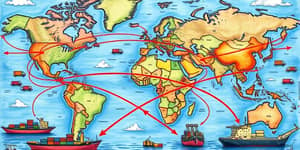
In an era of rapid change and uncertainty, understanding the forces shaping our world is more crucial than ever. As the global economy navigates a slower growth trajectory, businesses and investors must sharpen their analytical tools and adapt their strategies. This article offers an in-depth guide to identifying the trends that will define the winners of tomorrow.
By embracing a holistic perspective—one that blends data-driven insights with visionary leadership—you can stay ahead of the curve and find opportunities in unexpected places. Let’s dive into the factors driving economic shifts and explore practical approaches to thrive in this evolving landscape.
The pace of worldwide expansion is cooling, and key forecasts underline this shift. Major institutions predict that growth rates will dip below historical averages for the next two years. According to leading analysts, the global economy is set to grow at around 2.9% in 2025 and 2.8% in 2026, down from 3.3% in 2024. These figures signal a departure from the more robust growth seen in the post-recession recovery.
Several factors contribute to this moderation. Demographic headwinds, aging populations in advanced economies, and structural adjustments in emerging markets all play a role. Moreover, a heightened focus on risk management has led companies to adopt more cautious investment stances. Recognizing that the global economy is slowing is the first step in forecasting which sectors will excel despite these challenges.
Trade tensions and policy uncertainty have become defining features of the economic landscape. Tariff increases, especially between major players, create ripple effects across supply chains. When costs rise at the border, businesses must choose between absorbing higher expenses or passing them on to consumers—neither option is without consequences.
In response, forward-thinking organizations are diversifying their supplier networks and exploring nearshoring options. By building flexibility into procurement and production processes, they mitigate the impact of sudden tariff hikes. These adaptive measures underscore the importance of proactive planning in maintaining competitiveness under volatile trade conditions.
While inflationary pressures have eased since the peaks of recent years, they remain a critical concern—particularly in major economies. Core inflation is likely to trend downward but may settle above central bank targets for an extended period. In the United States, inflation is expected to hover around 2.1% in 2025, prompting policymakers to balance the twin goals of price stability and growth promotion.
The role of central banks is pivotal. With slower GDP expansion, many institutions may lower interest rates to stimulate demand. However, concerns about reigniting inflation could delay rate cuts. Businesses should prepare for a mixed environment of moderate borrowing costs and cautious consumer spending. Anticipating moves by monetary authorities will help organizations navigate funding strategies and capital allocation more effectively, thus managing economic volatility.
Economic trajectories vary significantly across regions. Understanding these nuances is essential for targeted decision-making. Here is a comparative snapshot of projected growth:
In the United States, elevated interest rates and fiscal deficits pose headwinds. Europe’s growth remains modest, yet structural reforms and green investments may accelerate recovery. China continues to outpace peers, even as its expansion moderates. Tailored strategies for each market will help organizations capitalize on region-specific dynamics.
Amid slower expansion, companies that pivot strategically can unlock new avenues of success. The following approaches have proven effective:
Digital and analytics-driven initiatives enable firms to refine product offerings and elevate operational performance. By prioritizing incremental innovation and nurturing existing customer relationships, businesses often realize higher returns compared to large-scale mergers and buyouts. This emphasis on sustainable scalability fosters resilience in fluctuating markets.
The traditional paradigm of maximizing shareholder value is evolving. A growing consensus advocates for an economic model that integrates environmental stewardship and social responsibility alongside profitability. This sustainable and socially responsible investments approach is rapidly gaining traction among investors and corporate leaders.
Companies adopting this mindset report advantages in brand loyalty, regulatory compliance, and access to capital. Whether through reduced carbon footprints, equitable labor practices, or community engagement programs, these organizations set themselves apart. They demonstrate that ethical considerations and long-term financial performance are not mutually exclusive.
As global growth slows and uncertainties persist, the winners of tomorrow will be those who combine analytical rigor with human-centered leadership. By understanding trade dynamics, monitoring monetary signals, and tailoring strategies to regional contexts, businesses can navigate complexity with confidence.
Embrace digital transformation, prioritize sustainable practices, and reinforce core strengths to foster building resilient business models. In doing so, you’ll not only weather current challenges but also unlock the potential for lasting success in the decades ahead.
References













